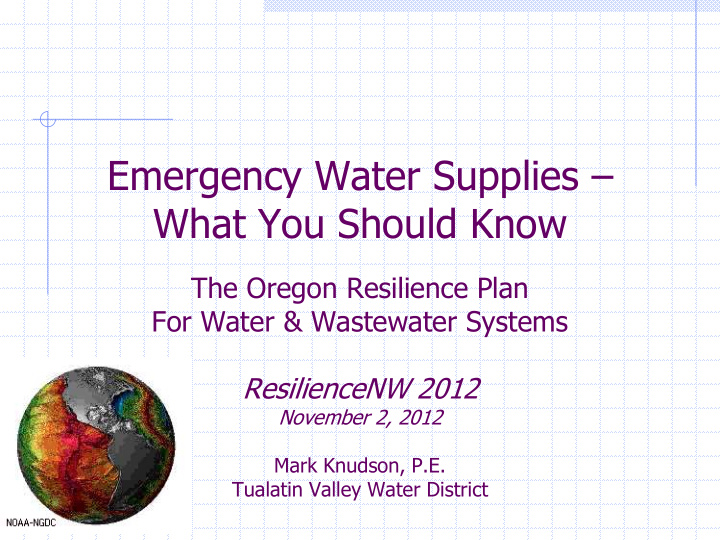



Emergency Water Supplies – What You Should Know The Oregon Resilience Plan For Water & Wastewater Systems ResilienceNW 2012 November 2, 2012 Mark Knudson, P.E. Tualatin Valley Water District
House Resolution 3 Assumes Cascadia Subduction Zone EQ & tsunami; M9.0 EQ with 500 year return period Assumes 50-year implementation period for recommendations Goals: protect lives & provide rapid economic recovery following event Plan to Legislature by February 28, 2013
The Oregon Resilience Plan Coordinated by Oregon Seismic Safety Policy Advisory Commission (OSSPAC) Task Groups Magnitude 9 Event – The Scenario Business Continuity Critical & Essential Buildings Energy Information & Communications Transportation Tsunami Risk Mitigation Water & Wastewater Four zones: Tsunami, Coast, Valley, East
Water & Wastewater
Why Are Water Systems Vulnerable? Causes of damage Tsunami (inundation) Shaking (acceleration & velocity) Permanent Ground Deformation (landslides, liquefaction, subsidence) Cumulative effects Inherent vulnerabilities of water systems
Why Are Water Systems Vulnerable? Large, complex systems, multiple failures Recovery highly dependent on other systems Location, location, location Age, age, age (and condition) Pipelines vulnerable to structural damage Pipelines vulnerable to ground deformation Connections to structures Leaks and breaks “after the meter” Collateral damage
Why Are Water Systems Vulnerable? Large, complex systems, multiple failures o Source, treatment, pumping, storage, distribution
Why Are Water Systems Vulnerable? Recovery highly dependent on other systems o Energy, transportation, people, equipment, financial
Why Are Water Systems Vulnerable? Location, location, location
Why Are Water Systems Vulnerable? Age, age, age (and condition)
Why Are Water Systems Vulnerable? Pipelines vulnerable to structural damage
Why Are Water Systems Vulnerable? Pipelines vulnerable to ground deformation
Why Are Water Systems Vulnerable? Connections to structures
Why Are Water Systems Vulnerable? Leaks, breaks & damage “after the meter”
Why Are Water Systems Vulnerable? Collateral damage
Water & Wastewater Resilience Plan Co-chairs: Mike Stuhr (PWB) and Mark Knudson (TVWD) Participants included representatives of ~ 45% of state Portland, TVWD, Salem, Gresham, Eugene, Coos Bay, Bend, Pendleton PSU, OSU, U of P, multiple consultants Approach Identify event (maps) Identify system requirements & community expectations Identify performance of existing systems Identify interdependencies (needs from others & demands on w-ww) Identify “gaps” in systems performance Generate recommendations
Requirements & Expectations Goals for time to restore systems Assumes “should be” resiliency improvements over 50 years For 30%, 60% and 90% operational capacity Based on input of economic interests; < 2 weeks Based on availability of interdependent sectors; energy & transpo Based on practical limitations; people, material & equipment Goals set for key functional components Emergency Water Distribution Fire Fighting Water source, treatment, transmission & distribution Wastewater collection, treatment & disposal
PGA, Landslides & Liquefaction
Water System Specific Mapping
Asset Inventory
Pipeline Performance Estimates Breaks Leaks Services Total Shaking 7 26 1,000 1,033 PGD 154 39 193 Total 161 65 1,000 1,226
Asset Inventory Pump Station and Reservoir Age (years) 100 B A C 90 Major Damage Significant Minor Damage (18 mo - 3 yrs) (3 mo - 6 mo) 80 (1 mo - 3 mo) 70 60 50 40 30 20 10 0
Target Recovery Time – Coast (non-Tsunami)
Target Recovery Time – Valley
Findings & Conclusions Significant gap between goals and existing state If CSZ EQ occurs today, it will result in dramatic change in “life as we know it” for W & WW o Most water systems will drain contents o Major structural damage to supply facilities, WTPs, pump stations o Change in traditional firefighting methods o Emergency water distribution required o Significant risks to public health & safety Water generally better prepared than wastewater o Wastewater limitations will create critical public heath risks o Need for wide-emergency sanitation o Contamination of rivers, steams o Contamination downstream of Portland – sewage & chemicals
Findings & Conclusions Eastern Oregon will experience limited impacts o Can serve as resource for staffing, material & equipment Tsunami areas will take years to recover, if ever Coast critically impacted; up to 3 years o High seismic impacts due to proximity to fault, PGD & subsidence o Highly isolated due to transportation & energy disruptions Extensive impacts to Valley; 6 months – 1 year o Extensive damage to facilities built prior to early 1990s o Recovery hampered by impacts to transportation & energy o Staffing, access to material & equipment critical limitations
Findings & Conclusions Resiliency upgrades will improve recovery times o Focus on system “backbone” & water supply to critical facilities o Coordinate with first responders to plan priorities & response o Coast (non-tsunami) could recover in 1 – 6 months o Valley could recover in < 1 month o Significant improvements in public health & safety Costs will be significant but can be managed o Have long-term plan for making improvements over 50 years o Invest in “backbone” and “low hanging fruit” o Include seismic improvements with ongoing investments o Incremental costs are limited when part of replacement & maintenance of aging infrastructure
Recommendations Reset public expectations for recovery times Require seismic assessments for all systems Encourage water & fire agencies coordinate plans Encourage upgrades; sanitary surveys & designs Encourage business continuity plans Encourage essential support for employee families Establish seismic design standards for pipelines Clarify regulatory expectations during emergency Encourage participation in ORWARN Establish emergency water distribution resources
Recommend
More recommend